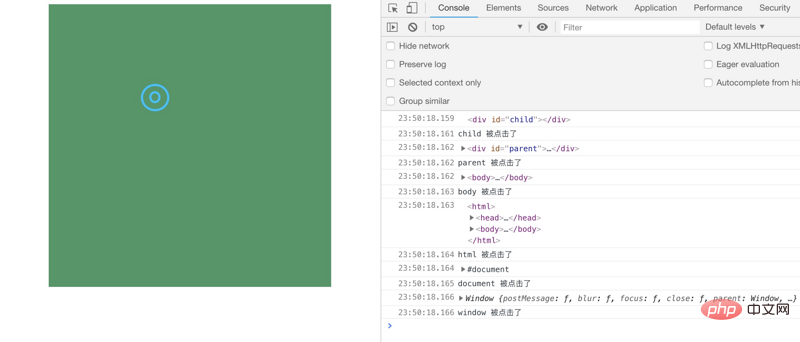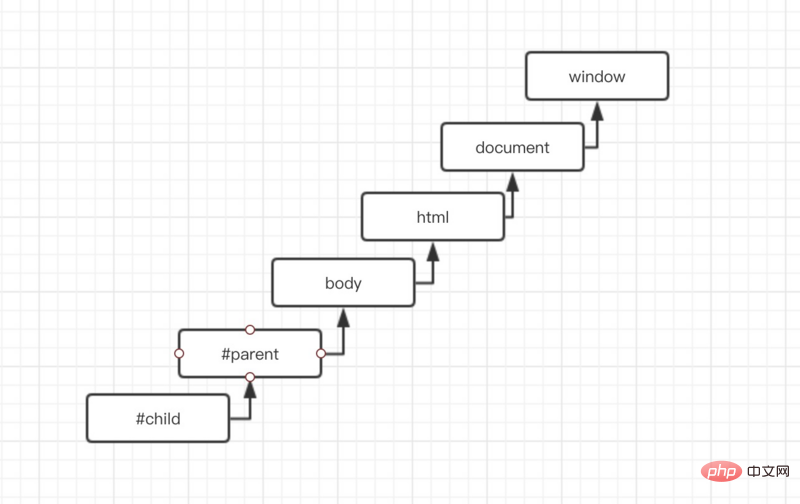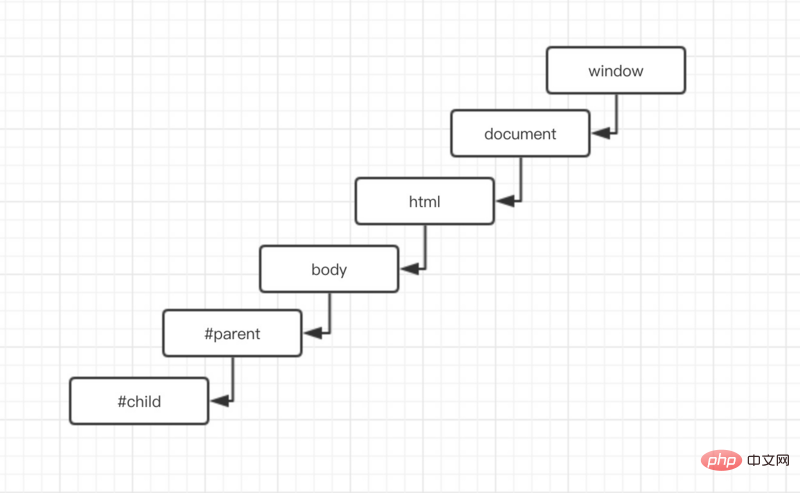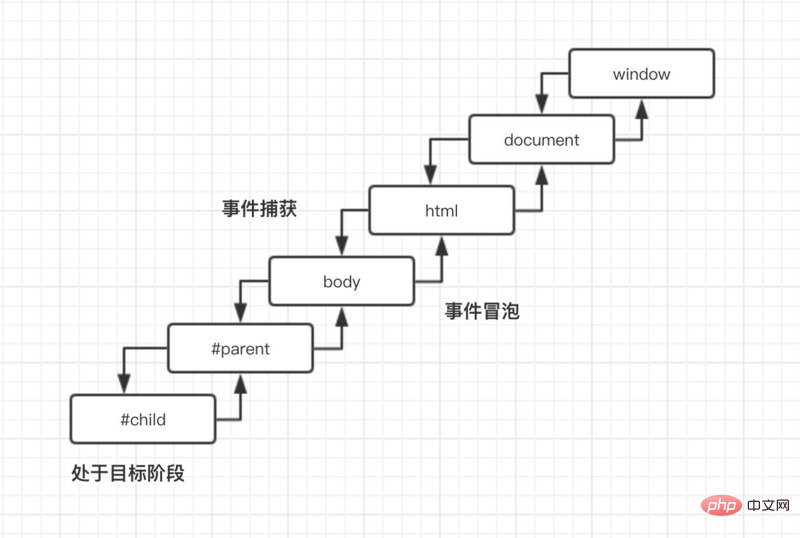Home >Web Front-end >JS Tutorial >Detailed explanation of event model in JavaScript (code example)
Detailed explanation of event model in JavaScript (code example)
- 不言forward
- 2018-11-21 11:47:411630browse
event
The interaction between users and web pages is realized through events. Events were initially used as a means to share server load. At first, there was no unified specification. It was not until the DOM2 level that Netscape and IE began to have their own API specifications.
Regarding the event triggering mechanism, both companies believe that the triggering mechanism of the page does not only trigger the event of the current target element when a certain element is clicked.
For example: the page has multiple concentric circles. When you click on the innermost circle, you actually click on the circles that include the outside of this circle. The two companies agree on this point, but the propagation sequence of the event stream is implemented using two different solutions, namely event bubbling and event capture.
1. Event bubbling
IE browser has always supported the event bubbling mechanism since the old version. The so-called event bubbling means that the event stream starts from a more specific element and continues to On dissemination of non-specific elements.
is propagated from the target element to the parent element.
<div>
<div></div>
</div>
<script>
function childEventHandler(event) {
console.log(this);
console.log("child 被点击了");
}
function parentEventHandler(event) {
console.log(this);
console.log("parent 被点击了");
}
function bodyEventHandler(event) {
console.log(this);
console.log("body 被点击了");
}
function htmlEventHandler(event) {
console.log(this);
console.log("html 被点击了");
}
function documentEventHandler(event) {
console.log(this);
console.log("document 被点击了");
}
function windowEventHandler(event) {
console.log(this);
console.log("window 被点击了");
}
var bodyEl = document.getElementsByTagName("body")[0];
var htmlEl = document.getElementsByTagName("html")[0];
var win = window;
var parentEl = document.getElementById("parent");
var childEl = document.getElementById("child");
childEl.onclick = childEventHandler;
parentEl.onclick = parentEventHandler;
bodyEl.onclick = bodyEventHandler;
htmlEl.onclick = htmlEventHandler;
document.onclick = documentEventHandler;
win.onclick = windowEventHandler;
</script>
As shown in the figure below, if you click on the element with the id of child, the event flow will propagate from the child to the window object.




1.
<div></div>
2.
var childEl = document.getElementById("child");
childEl.onclick = function() {
console.log('hello');
}
3.
var childEl = document.getElementById("child");
childEl.addEventListener('click', function() {
console.log('hello');
}, false);JavaScript It is a single-threaded language. When an event is triggered on an element, it will search the event queue to see if there is a function bound to the event. If there is not, it will do nothing. If there is, the function will be placed in the event queue. In front of, wait for the main thread event to be executed after execution. The first binding of the above code writes the event in html, and the performance and behavior are not decoupled. It is not recommended to write code in this way. The second type of binding binds events to element objects. This writing method is mainly easy to overwrite events. The third binding, first of all, the third parameter is a Boolean value, the default is false, which means that the event handler is called in the event bubbling stage. If it is true, it means that the event handler is called in the event capture stage. function. When we want to process an event and do not want to process the event binding of the element, we should set the event binding of the element to empty, if memory leaks are prone to occur.
第一种写法:
childEl.onclick = null;
第三种写法:
function eventHandler() {
console.log('hello');
}
childEl.addEventListener('click', eventHandler, false);
childEl.removeEventListener('click', eventHandler, false);5. Event delegation (event proxy)Event delegation takes advantage of the nature of event bubbling. The event stream starts from receiving more specific elements and continues to spread to unspecific elements. . First of all, if there is a list ul, each list element li click will trigger the event handler. Obviously, if you bind events to the elements one by one, the efficiency will definitely not be good. At the same time, when a new element is added, the event may not be bound successfully. Let’s take a look at it together:
- menu-1
- menu-2
- menu-3
- menu-4
我们通过事件委托的思路来想,事件流的传播,目标元素本身依然会有事件,但同时,冒泡出去后,更高层次的 dom 也能处理事件程序。那么,我们只需要给高层次节点绑定事件,通过判断具体是触发的哪个子节点,再做相应的事件处理。
- menu-1
- menu-2
- menu-3
- menu-4
menu 列表的每个子菜单元素的事件都能正确响应,新增的 menu-new 同样也能正确响应事件。
事件委托的好处在于,我们不用给每个元素都一一地手动添加绑定事件,避免重复低效的工作。
其次,事件委托更少得获取 dom, 初始化元素对象和事件函数,能有效减少内存占用。
每当将事件程序指定给元素时,html 代码和 js 代码之间就建立了一个连接,这种连接越多,网页就执行起来越慢,所以事件委托能有效减少连接树,提高网页性能。
总结
用户与网页的交互是通过事件进行的,事件模型分为事件冒泡和事件捕获,事件冒泡的兼容性更好,应用更广,同时通过事件冒泡,可以建立事件委托,提升网页性能。
The above is the detailed content of Detailed explanation of event model in JavaScript (code example). For more information, please follow other related articles on the PHP Chinese website!
Related articles
See more- Detailed explanation of JavaScript event model, objects, monitoring, and delivery code examples
- Take you to quickly understand the event model in JavaScript
- Detailed explanation of JS event model
- JavaScript event model (graphic tutorial)
- Introduction to JavaScript event model (graphic tutorial)
- Analysis of event model in js

